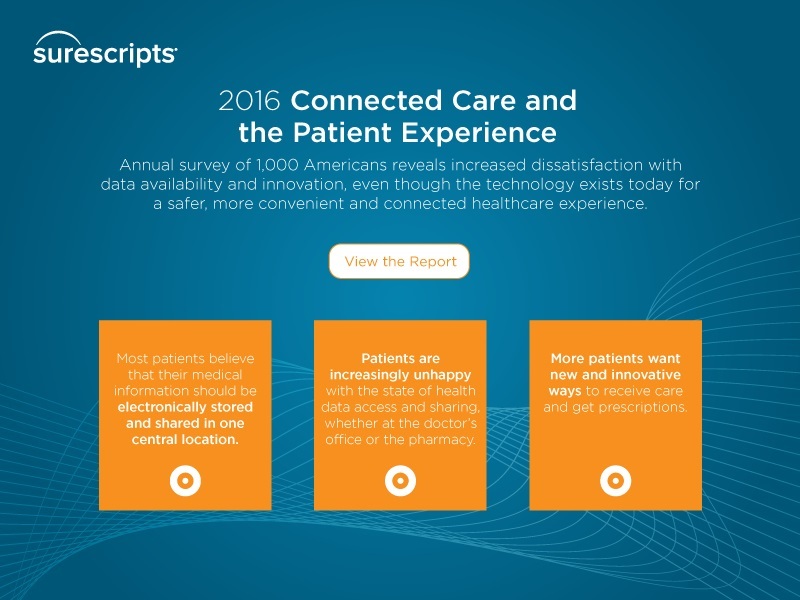Why can’t th e healthcare consumer experience be as easy as online banking? asks Tom Skelton, the CEO of Surescripts.
e healthcare consumer experience be as easy as online banking? asks Tom Skelton, the CEO of Surescripts.
That’s the expectation of most U.S. healthcare consumers, based on Surescripts latest survey results, summarized in the 2016 Connected Care and the Patient Experience report.
The key findings are that U.S. consumers,
- Want their medical information delivered electronically, easily accessible and shareable;
- Are dissatisfied with the time and effort they spend on dealing with their medical information and waiting times in health care offices, both doctors and pharmacies; and,
- Prefer and expect innovative ways to get care and prescriptions.
People are getting much more savvy about the benefits of digitized/electronic personal health information: Surescripts found that 9 in 10 patients believe their doctor would be less likely to prescribe the wrong medication if they had more complete information, avoiding medical errors — probably the most important direct benefit for patients and their loved ones. 9 in 10 consumers also believe their lives are at stake when their doctors don’t have their complete medication history.
Furthermore, most people are willing to share more information about their health: 77% of health consumers would share physical information, 69% would share insurance information, and 51% would share mental health information.
There’s also evidence that patients are getting more information-engaged in their health: 58% of people have tried to assemble their own medical history. We know physicians are over-burdened with health information workflow. Patients feel their own kind of pain for personal health information workflow: 54% of people say renewing a driver’s license requires less paperwork.
Patients’ paperwork pain-point is also evidenced by the data point that 4 in 10 people would be less likely to visit a physician who does not do e-prescribing.
Finally, most patients (52%) now expect the ability to conduct remote visits with doctors, which would facilitate receiving prescriptions remotely from doctors making life easier and time-saving.
Health Populi’s Hot Points: Patients, facing greater price transparency, first-dollar out-of-pocket payments, and more self-service/DIY workflows in daily life expect retail-style service from all aspects of healthcare: in the doctor’s office, at the hospital, in the pharmacy, and from the insurance company. These services levels aren’t nearly at the level of an Amazon, a Nordstrom, or an Uber. Consider your favorite service experience, and compare it to your most recent healthcare encounter.
Layer on top of this the importance for greater price transparency, the kind of which we find in retail and from digital companies we deal with online, increasingly via mobile. Transparency is the second experience challenge for healthcare industry stakeholders to tackle in parallel with the digital health platform development.
We see a growing cadre of health consumers, driven by Millennials, seeking convenient, value-priced, mobile and virtual care. This transition has already begun, along with a growing value consciousness among payers. To stay relevant and valued by consumers, hospitals, physicians, pharmacies, and suppliers to the industry (pharma, medical device, et. al.) must respond to this increasingly consumer-directed health care mandate.




 Interviewed live on BNN Bloomberg (Canada) on the market for GLP-1 drugs for weight loss and their impact on both the health care system and consumer goods and services -- notably, food, nutrition, retail health, gyms, and other sectors.
Interviewed live on BNN Bloomberg (Canada) on the market for GLP-1 drugs for weight loss and their impact on both the health care system and consumer goods and services -- notably, food, nutrition, retail health, gyms, and other sectors. Thank you, Feedspot, for
Thank you, Feedspot, for  As you may know, I have been splitting work- and living-time between the U.S. and the E.U., most recently living in and working from Brussels. In the month of September 2024, I'll be splitting time between London and other parts of the U.K., and Italy where I'll be working with clients on consumer health, self-care and home care focused on food-as-medicine, digital health, business and scenario planning for the future...
As you may know, I have been splitting work- and living-time between the U.S. and the E.U., most recently living in and working from Brussels. In the month of September 2024, I'll be splitting time between London and other parts of the U.K., and Italy where I'll be working with clients on consumer health, self-care and home care focused on food-as-medicine, digital health, business and scenario planning for the future...